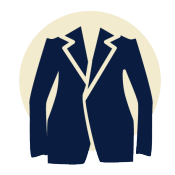Dress for Success Reference Guide
Dressing Appropriately for Work and Professional Events
Dressing professionally refers to wearing clothes and accessories designed for a professional workplace. Professional outfits are modest, well tailored and free of images or graphics. Your clothes should be clean, ironed and free of rips, holes or stains. The level of formality of each environment differs, so dressing professionally in one setting may mean wearing a suit while another enviroment may advise a more casual style such as khaki pants and a company polo.
The JCPenney Leadership Program provides many opportunity to interact with business and industry. We host varied events throughout the year, some more formal than others. The categories you should be familiar with are as follows:

Casual attire is informal clothing such as jeans and t-shirts. In a casual setting sneakers are acceptable. JCPenney Leadership Program branded attire is strongly suggested, if available.

Informal, yet stylish. Snappy Casual is considered dressier than a basic t-shirt and jeans. Some examples include slacks or khakis or a very dark wash denim. Tops should include collared shirts, or blouses. Tennis shoes are not acceptable footwear.

Business casual is a level above everyday and snappy casual but not as dressy as business professional. Business casual tops include: collared shirts, well fitted blouses or sweaters. Footwear should be dress shoes.
Example Event:
Regular Organizational Meetings and OU faculty led events
Example Event:
Networking Brunch/Evening Mixers
Example Event:
Lunch & Learns with Corporate Partners

Business professional is a traditional form of attire used in more conservative settings or companies with strict dress codes. You might wear business professional in industries like accounting, banking, finance, government or law. Business professional clothes should be well-fitted and may be tailored to fit you specifically. Jacket and pants/skirts need to be of the same color and fabric. A necktie is required for men. Jewelry should compliment your attire while expressing your personal style. Dress shoes are a must and should match your belt. Closed toe shoes only.

Business formal is reserved for the most formal settings such as award ceremonies, special dinners, benefits or other important evening events. Business formal is similar to “black tie,” but should be reserved to maintain professionalism. When in doubt feel free to ask the host for guidance on dress standards for a particular event.
Example Event:
Job Interviews, Distinguished Speakers Events, Corporate Views
Example Event:
End of Year Awards Gala
Dos and Don'ts
- Well groomed hairstyles
- Appropriate close-toed shoes
- Dresses and skirts at or below the knee
- Choose matching colors, patterns, and accessories
- Match your socks to your pants, and your belt to your shoes
- Make sure your hands are clean and well groomed - avoid chipped polish
- Check yourself in the full length mirror one last time before heading out
Ripped, torn or frayed clothing
Low-cut or revealing clothing
Sandals or flip-flops
Cropped shirts
Shorts
Skirts or dresses with high hemlines
(well above the knee)Sweatshirts or sweatpants
Off-the-shoulder shirts or dresses
Excessive or noisy jewelry
Athletic shoes
Hats
Additional Resources
- The Importance of Dressing Professionally at Work
- Students Guide to Business Attire
- Guide to Business Attire (with examples)
- Guide to Snappy Casual Attire (with examples)
- Guide to Business Casual Attire (with examples)
- Guide to Business Professional (with examples)

